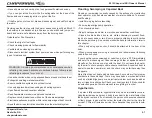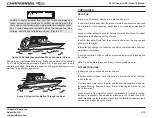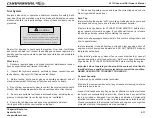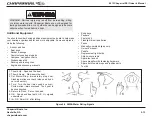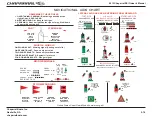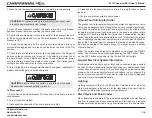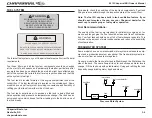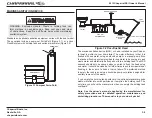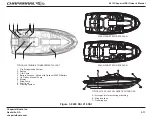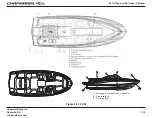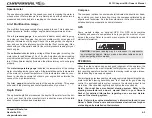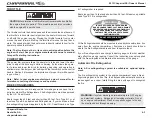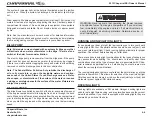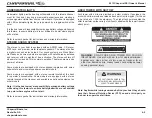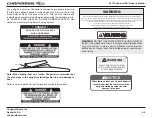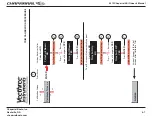
2013 Chaparral SSi Owner’s Manual
Chaparral Boats, Inc.
Nashville, GA
chaparralboats.com
3-5
current is “leaking” into the water, and can come from a variety of things
such as ship to shore power, sharing electrical wires, old electrical de-
vices in contact with the water, batteries in boats, etc.
Electrolysis can also be caused by “stray currents” due to a fault in an
electrical item, even though correctly grounded.
Electrolysis/corrosion is a very real issue and expense for any boater and
boat owners must be aware of the proper protection and maintenance.
Corrosion will directly affect the performance of your boat within a very
short period of time.
It is the boat owner’s responsibility to check for and replace damaged
parts due to galvanic deterioration. Refer to your Chaparral dealer to in-
vestigate the source of stray corrosive currents.
Sacrifi cial anodes are installed on the outdrive and trim tabs to protect
underwater hardware on your boat. Metals used in sacrifi cial anodes are
less noble than the copper-based alloys and aluminum used in under-
water fi ttings; therefore, the anodes will deteriorate fi rst and protect the
more noble parts. Metals commonly used in sacrifi cial anodes include
aluminum, magnesium and zinc.
The type of metal needed for your boat’s sacrifi cial anodes will depend on
your use of the boat. For instance, the type of water where you commonly
go boating is a major factor in determining your need. Chaparral recom-
mends you consult your dealer and you engine manufacturer’s owner’s
manual to determine the proper metal needed in your sacrifi cial anodes.
Zinc anodes generally require replacement about once a year, but may
need to be replaced every six months in salt water areas. The need to
replace anodes more frequently may indicate a stray current problem
within the boat or at the slip or mooring. If zinc anodes are not replaced
annually, they may not be providing the necessary protection.
Note: Do not paint between the zinc and any metal it touches. Do not
paint over the zinc.
Placing a zinc in the water bonded to the metal outlet box on the dock
will reduce zinc loss on the boat. Do not connect this zinc to the boat’s
ground system.
Important: All electrically operated DC equipment and accessories
must be wired so that the ground polarity of each device is the same
as that of the battery. Chaparral boats have a negative ground sys-
tem, which is recommended practice throughout the marine indus-
try. All metal items (fuel tanks, underwater hardware) in the boat are
connected to the zinc anode by the green bonding wire.
Once a year
(Performed by a qualifi ed marine technician)
• Verify the integrity of the boat’s entire AC shore power grounding sys-
tem, including the connection to the DC system negative.
• Verify that any galvanic isolators (if installed on your boat) meet current
American Boat & Yacht Council (ABYC) standards and are fully func-
tional.
CAUTION: Replace sacrifi cial anodes if they are corroded 50%
or more.
• Inspect shore power cords, adapters and boat receptacles for any signs
of deterioration, including cord wear, loose connections, signs of spark-
ing or overheating and bent or pitted blades. If there are any such signs,
examine, correct, and test the equipment or replace it.
• Operate the boat’s electrical system at full load (everything on) and
check for AC system leakage or voltage between the boat’s underwa-
ter fi ttings (bonded system, if equipped) and the shore side AC system
ground.
Galvanic Isolator
A galvanic isolator is installed in your boat and electrically connected be-
tween the boat’s AC panel ground and the dockside AC ground wire. The
galvanic isolator is designed to permit AC ground currents to pass safely
between the boat and the dockside but to block the small DC currents
that fl ow in seawater between boats in a marina because of different
metals on the boats that are in the water. When the shore power cord is
connected to the boat and breaker, the green light on the panel should
be on.



